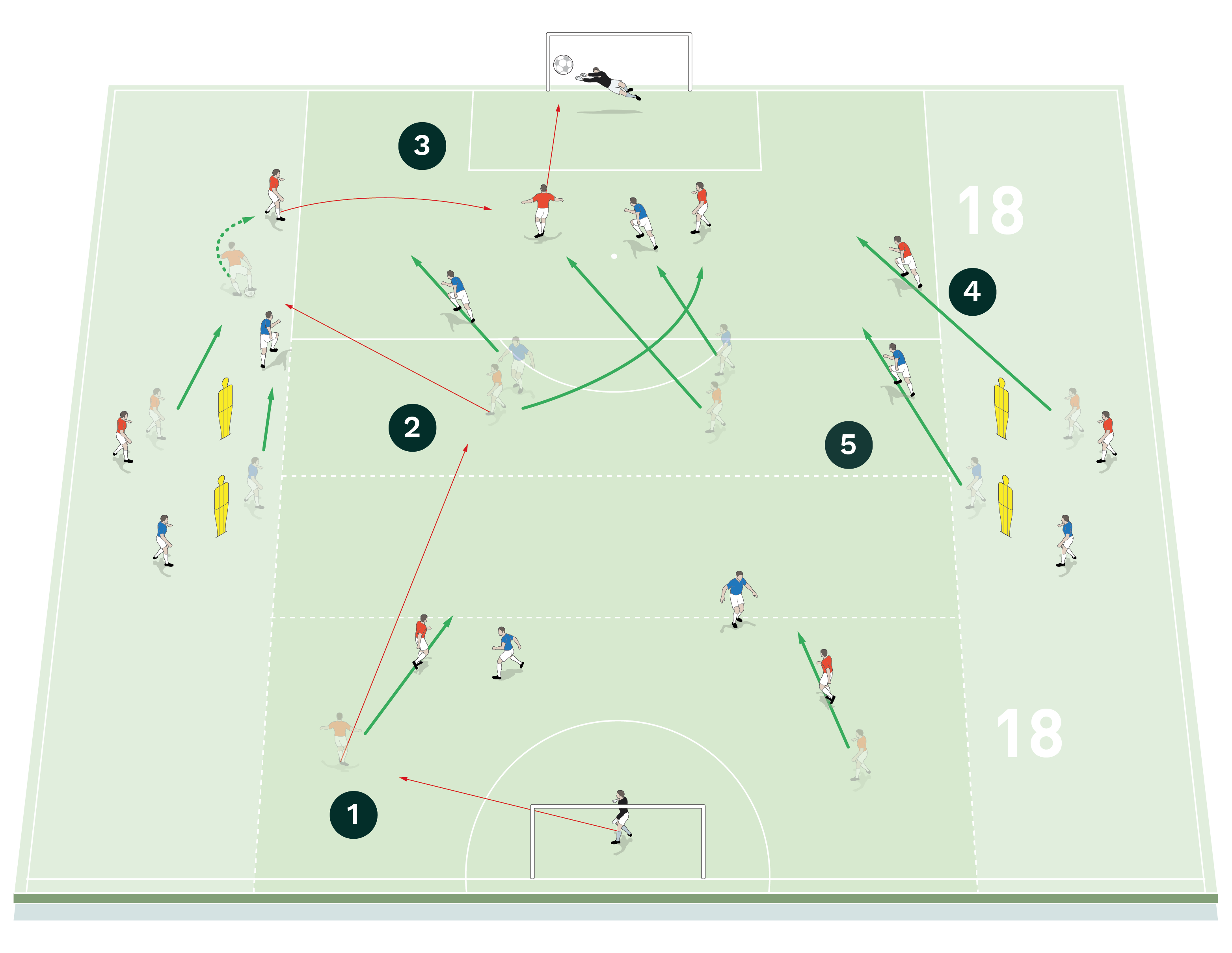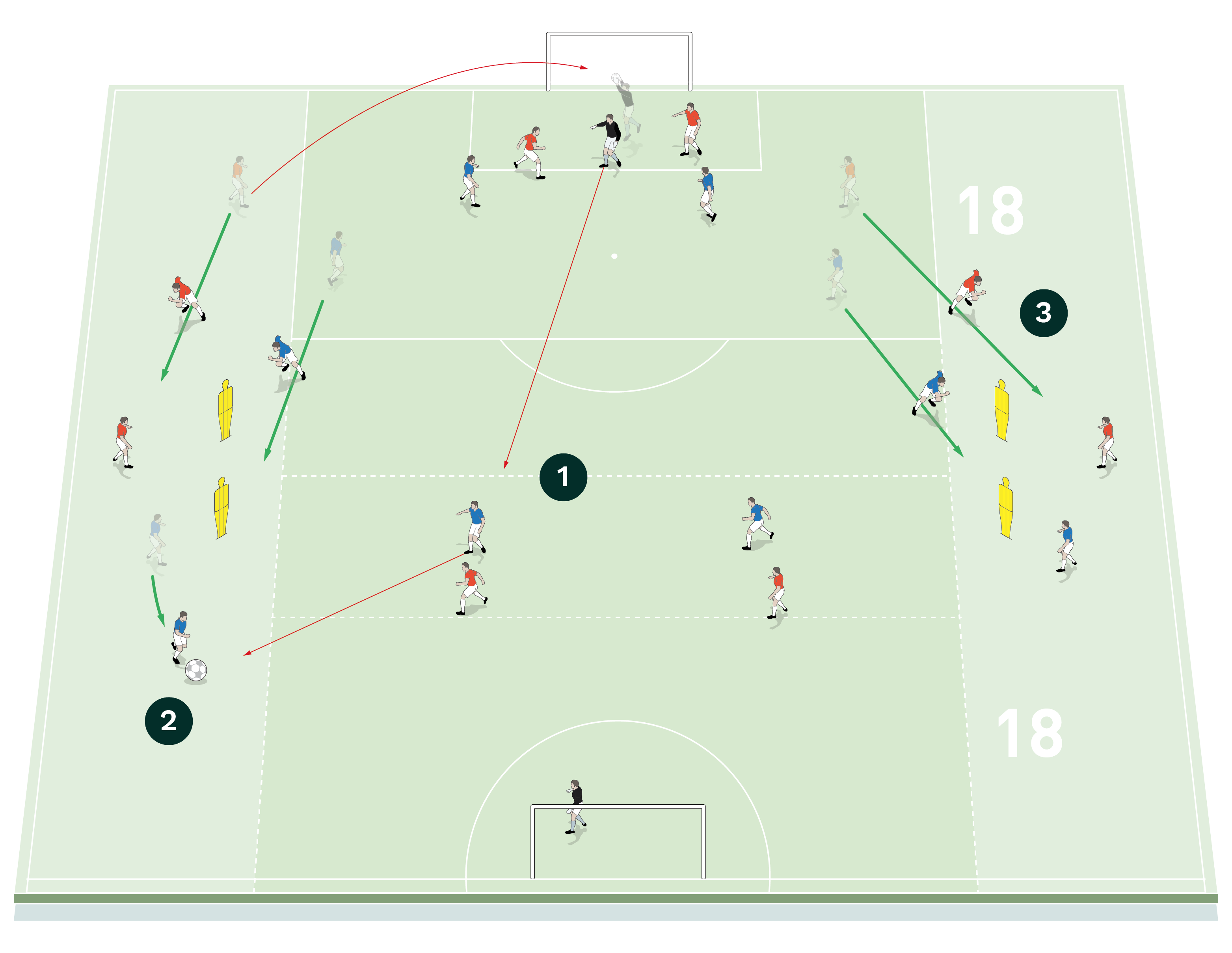Transition Play

| Area | Half a pitch |
| Equipment | Balls, bibs, cones, 4 mannequins, 2 full size goals |
| No. of Players | 16 players + 2 goalkeepers |
| Session Time | 30mins |
The main focus of this session is on transitional play, where we aim to hit the wide areas of the pitch as quickly as possible. We then look at the many variations of how we hit the wide areas. For example, playing the ball wide directly from the goalkeeper, or playing it into the striker and then out wide, or sliding passes out wide from central areas.
This session gets everyone engaged as it has a variety of components that we can work on. It also allows my staff to work on other areas of play. I can allocate one coach to work on defending the cross, while another coach works on the press and how we prevent the possession team from building an attack and playing forward and wide.
This session allows players to be creative in the final third. It focuses on the quick transition that allows players the freedom to attack the goal at pace and quickly score. On the flip side of the attacking transition, we can also use it to look at the defensive transition and how players should recover at speed.
It’s not a session we run every week, but it is one we will revisit if we recognise that we need to hit the wide areas against our upcoming opponents. If we notice that our forthcoming opposition like to get their full backs high when in possession, we will use this session as a reminder to the players to hit those wide spaces in behind.
“We will revisit this session if we recognise that we need to hit the wide areas against our upcoming opponents”
TRANSITION GAME
We set up on half a pitch with a goal and a goalkeeper at each end. The main playing area is coned of to the width of the penalty area and an 18-yard box is marked out in front of each goal. A wide channel flanks the main playing area on either side and mannequins are positioned outside the halfway line as starting points for the wide players and full backs.
We’re using 16 outfield players split into two teams of eight. In each half a pair of central defenders come up against two strikers in a 2v2, or a 3v2 including the goalkeeper. The wide players and full backs for each team wait outside of the main playing area in the wide channels on either side of the halfway line. The attacking teams wingers should be positioned at the mannequins in their attacker’s half, as shown.
Play starts with the red goalkeeper, who passes the ball out to a central defender to build play from the back in a 3v2 situation.
[1a]

2. The red possession team looks to pass the ball forwards into a striker in the attacking half. The red striker then combines with a wide player on the outside
3. The red wide player crosses, with the forwards making well-timed runs to meet the ball and finish
4. The red attacking team’s wide player on the opposite side of the pitch can join in by making a supporting back-post run
5. The opposition full backs can also make recovery runs to help their team to defend, but they can only do so once the ball has crossed the halfway line
“What I am looking for in this session is an awareness of how to exploit the wide areas of the pitch as quickly as we can”
[1b]

2. The striker brings an outside wide player into the game with a pass out into the wide channel and the blues counter-attack
3. The recovering full backs and the attacking wide players from the previous attack should now sprint back into their original starting positions in the outside channels
“We encourage players to slide passes across the floor. The aim is to attack quickly, so we need players to recognise the type of pass that will allow that”
The aim for the possession team is to pass the ball forwards into a striker in the attacking half. The red striker then combines with a wide player on the outside, who has made a supporting forward run to receive. The attacking team aims to produce a cross and a finish, with the forwards making well-timed runs to meet the ball.
The attacking team’s wide player on the opposite side of the pitch can join in by making a supporting back-post run into the main playing area, creating an initial 3v2 overload in favour of the red attacking team. One opposition full back from each wide channel can also make recovery runs to help their team to defend, but they can only do so once the ball has crossed the halfway line, as shown [1a].
If the red forwards fail to get on the end of the cross and it is claimed by the opposition goalkeeper, the ball can be distributed immediately into one of the two strikers on their team. The practice now continues in the opposite direction, with the blue striker bringing an outside wide player into the game with a pass out into the wide channels. The recovering red full backs from the previous attack should now sprint back into their original starting positions in the outside channels, as shown [1b].
On receiving the ball from the keeper, the striker can link up with either outside wide player and, as a progression, the wide player can also now drive inside the main playing area with the ball and is free to shoot at goal from an angle. The opposite wide player continues to join the attack by making runs to the back post area, as shown [1c].
The session can be progressed further by allowing the possession team to build play with a pass directly into the wide area rather than going straight into the striker first.
[1c]

2. As a progression, the wide player can also now drive inside the main playing area with the ball and is free to shoot at an angle
COACHING POINTS
What are the key things to look for?
What I am looking for in this session is an awareness of how to exploit the wide areas of the pitch as quickly as we can. I want to see players winning the ball in our half and then playing forward quickly to get in behind the opposition full back. If we are unable to play forward quickly, then the next best option is to maintain possession and build.
Once we win the ball, we need to recognise whether our striker can receive or if we can play directly wide. I am therefore looking at the striker’s body positions: have they been pinned by the defender or are they moving into pockets of space?
I’m then looking for the quality of the pass into the wide areas: is it to feet, is it into space? What does the pass say to the wide player: play off one-touch or play off two-touch? Lastly, we want to see good supporting movement from the attacking team.
What are the typical mistakes players might make and how do I avoid them?
A typical mistake players can make is to force play wide when it isn’t on. Sometimes players must turn the option down and build play a different way.
Another common mistake occurs when players look to play a high ball into the wide area. This makes it harder for the wide player to play off one-touch. To remedy this we encourage players to slide passes across the floor. The aim is to play and attack quickly, therefore we need players to recognise the type of pass that will allow that.
How long does the session last?
It can last for 30 minutes. This includes jumping in with coaching points and progressions. I have always found the players enjoy this session, so don’t be afraid to overrun it slightly. The most important thing is that you make your messages clear.
Editor's Picks
Attacking transitions
Jesse Marsch
Deep runs in the final third
Fabian Hürzeler
Using the goalkeeper in build-up play
Ralph Hasenhüttl
Intensive boxes drill with goals
Andoni Iraola
Penetrating the final third
Ange Postecoglou
Creating and finishing
Pep Guardiola
My philosophy
Sir Alex Ferguson
Pressing initiation
Mauricio Pochettino
Compact team movement
Roberto Martinez
Coaches' Testimonials

Alan Pardew

Arsène Wenger

Brendan Rodgers

Carlos Carvalhal

José Mourinho

Jürgen Klopp

Pep Guardiola

Roy Hodgson

Sir Alex Ferguson

Steven Gerrard
Coaches' Testimonials

Gerald Kearney, Downtown Las Vegas Soccer Club

Paul Butler, Florida, USA

Rick Shields, Springboro, USA

Tony Green, Pierrefonds Titans, Quebec, Canada
Join the world's leading coaches and managers and discover for yourself one of the best kept secrets in coaching. No other training tool on the planet is written or read by the calibre of names you’ll find in Elite Soccer.
In a recent survey 92% of subscribers said Elite Soccer makes them more confident, 89% said it makes them a more effective coach and 91% said it makes them more inspired.
Get Monthly Inspiration
All the latest techniques and approaches
Since 2010 Elite Soccer has given subscribers exclusive insight into the training ground practices of the world’s best coaches. Published in partnership with the League Managers Association we have unparalleled access to the leading lights in the English leagues, as well as a host of international managers.
Elite Soccer exclusively features sessions written by the coaches themselves. There are no observed sessions and no sessions “in the style of”, just first-hand advice delivered direct to you from the coach.









